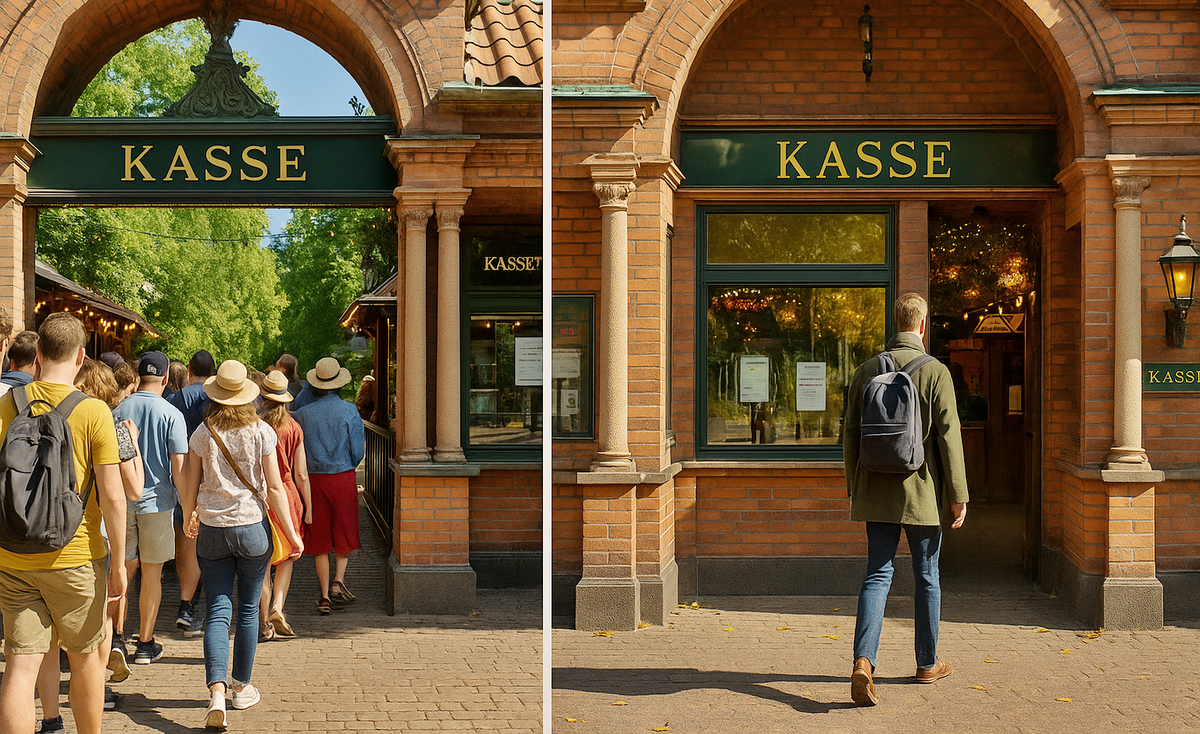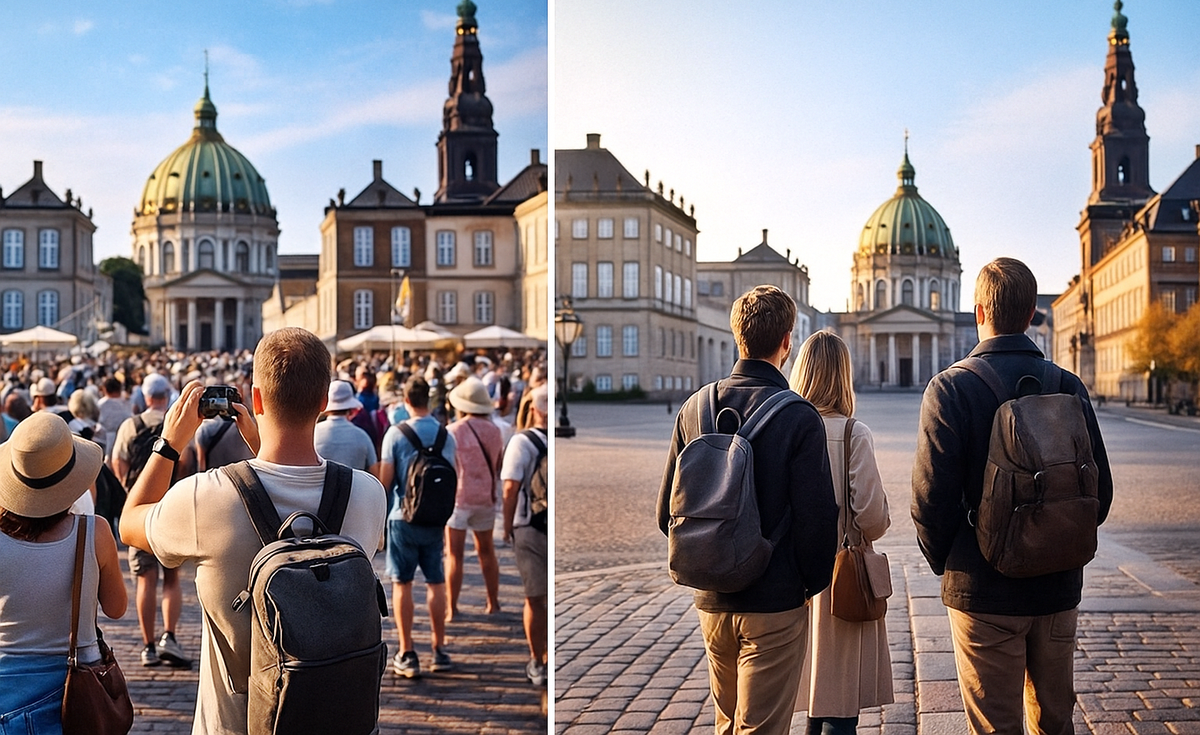🌗 Shoulder season: May and September — comfort without the July crowds
May and September are the perfect ‘shoulder season’: the time between low and high season, when it's already (or still) nice, but not yet ‘July hell’ in terms of prices and crowds. Many guides to Denmark specifically highlight late spring and early autumn as the sweet spot: the weather is already comfortable, but the mass tourist flow is just getting started or has already begun to decline.
From tourist reviews about September: ‘We arrived at the beginning of the month — there are noticeably fewer people, no queues, everything works, the city is lively but not crowded.’
The main question of this article:
If I don't want the July crowds and sky-high prices, but I'm afraid of the cold and grey weather, are May or September suitable for me?
🌦️ Weather and atmosphere: May vs September ‘on the skin’ rather than in degrees

🌱 May: spring in full swing
According to climate statistics for Copenhagen in May:
- average daytime temperatures are around +15...+16 °C,
- night-time temperatures are around +8 °C,
- there are around 10–12 rainy days per month, but these are usually short, passing showers.
In practice, it feels like this:
- in the morning, it is cool in just a sweatshirt, so you need a windbreaker or a light jacket;
- during the day, in the sun and without wind, you can sit comfortably on the terrace in jeans and a jumper;
- the greenery is already ‘turned on’: parks, lilacs, tulips, people go out to the squares.
The atmosphere is ‘the start of the season’: cafes bring tables out onto the street, people appear by the water, but there is no feeling that the city is ‘packed to the rafters’. The tourist flow is growing, but it is still far from peak load.
Live feedback: someone honestly writes that ‘in May, we walked without a jacket one day, and the next day we were back in a scarf, but the city is blooming and the crowds are tolerable so far.’
🍂 September: the remnants of summer and the first ‘wool’
According to data for September in Copenhagen:
- during the day +16...+17 °C at the beginning of the month and closer to +14 °C by the end,
- at night around +10...+12 °C,
- precipitation slightly more than in May (on average 50-60 mm and up to 14 rainy days).
How it feels:
- During the day, jeans and a jumper are comfortable, but wind and rain can suddenly make it less cosy.
- The days are already shorter than in July, but it is not yet winter darkness — it is quite comfortable to walk and take photos.
- Parks and suburban forests take on a golden hue, and the embankments are bathed in soft, warm light.
Travel guides mark September as the end of the season: the city is still bustling with street life, but there are fewer tourists, shorter queues, and a calmer pace.
🧥 General conclusion on clothing and swimming
In both May and September, you need a layered wardrobe:
- a base layer + sweater + windbreaker/light jacket,
- waterproof shoes — not as an ‘option’ but as a must-have.
Swimming in the harbour and on the beaches:
- in May — more of a symbolic ‘feat’ for the hardy;
- in September, at the beginning of the month, you may be lucky enough to have a couple of really warm days, but this is a bonus, not a guarantee.
👥 Crowds and prices: why the shoulder season is really beneficial

🚶♀️ Crowds
July–August is the peak tourist season: long days, festivals, half of Europe on holiday, longer queues at popular spots (Nyhavn, Tivoli, castles, popular cafés).
In May and September, the picture is different:
- there are fewer tourists,
- the canals and museums are less crowded,
- and in the evening it is easier to find a table on the terrace without a long wait.
Some authors directly call May and September the best compromise in terms of the balance between weather, crowds and prices.
💶 Prices
According to reviews and ratings:
- accommodation and air tickets in May/September are often cheaper than in the ‘heart’ of the season (July — first half of August), especially if you are not tied to weekends;
- However, this is not a hard and fast rule — prices are greatly influenced by specific dates and events (festivals, large conferences, marathons).
An important nuance:
- May holidays in Europe,
- major festivals and congresses in certain weeks of September — during these periods, the shoulder season feels almost like July in terms of both occupancy and prices.
🗺️ 3–5-day trip formats: how to ‘unlock’ May and September

📆 3 days in May: spring city setup
Day 1 — Classics + water
- Morning: historic centre, Strøget, squares.
- Day: palace/castle (Christiansborg, Rosenborg), nearby park.
- Evening: Nyhavn + walk or canal cruise (at sunset — perfect timing).
Day 2 — Neighbourhoods and greenery
- Day: Vesterbro or Nørrebro — street cafes, small shops, street art.
- Walk through parks (e.g. King's Garden, Østerbro parks) and along the embankments.
Day 3 — Easy getaway or another neighbourhood day
- Option A: trip to Roskilde or one of the castles in Zealand.
- Option B: another ‘city’ day with an emphasis on cycling and embankments, plus cafes and pastry shops.
The focus in May is on greenery and movement: more streets, bike rides, the first terraces, picnics in parks.
📆 3 days in September: a balance of street life and hygge
Day 1 — City centre + canals + cosy evening
- Day: city centre, Nyhavn, main ‘postcard’ views.
- Evening: dinner, wine/craft bar, walk along the illuminated streets.
Day 2 — Museums + markets/cafes
- Day: 1–2 large museums or design centres + indoor markets and food courts.
- Evening: bar/wine bar or quiet cafe — a typical September ‘woollen’ scenario.
Day 3 — Departure or long walk
- Option A: day trip (castle + small town in Zealand).
- Option B: combination of ‘another museum + long walk in the park/along the embankment’ with autumn scenery.
📆 4–5 days in the shoulder season
For 4–5 days, the logic is roughly the same for May and September:
- 3–3.5 days — Copenhagen and surrounding areas (city centre + 2–3 different districts, cycling, waterfronts, parks, gastronomy).
- 1–2 days — for trips:
- Zealand (Kronborg, Frederiksborg, Roskilde),
- if desired — Aarhus or Odense by train, but without the summer price and tourist peak.
In May, you can make the most of the greenery, walks and cycling.
In September, there is a balance between the streets and cafés/museums, especially towards the end of the month when the evenings become noticeably cooler and darker.
🎯 May or September — and typical mistakes
👤 Who is May more suitable for
May is for those who:
- love blooming parks and the feeling of ‘early summer’;
- can't stand the heat and crowds, but aren't afraid of a fresh breeze;
- want to walk and cycle a lot, sit outside, but understand that the evenings will be cooler.
👤 Who is September more suitable for
September is for those who:
- love a slightly cooler, ‘woolly’ season;
- appreciate cafés, gastronomy, and leisurely strolls ‘from the museum to the bar’;
- want fewer tourists and slightly lower prices than in July and August.
⚠️ Typical mistakes
- Expecting ‘beach’ Copenhagen in May: the water is cold, the evenings are cool, and the wind regularly reminds you that this is still the North.
- Thinking that at the end of September it is ‘still summer’: the days are shorter, there is more rain and wind, so you need a flexible plan with a reserve of indoor activities.
- Ignoring events: you may accidentally end up in the middle of a major conference or festival and encounter prices and crowds almost like in July.
- Packing your suitcase ‘as if it were July’: no layers, no raincoat, and no proper shoes. This is a guaranteed recipe for a ruined mood in any northern spring/autumn.
✅ Mini checklist for planning
May and September in Denmark are a great alternative to the July peak:
- mild weather without extreme heat,
- fewer crowds and queues,
- often more reasonable prices for accommodation and flights,
- a 3-5 day format where you can take your time and easily add 1-2 trips.
📝 Mini checklist for yourself:
- I want fewer people and am not a fan of heat → look at May/September.
- I love greenery, flowers and the ‘start of the season’ → May.
- I love the lightness of ‘almost autumn’, soft light and cafés → September.
- Are you ready for layers of clothing, wind and possible rain? If so, the shoulder season is your ally, not a ‘half-measure’ between summer and winter.
FAQ
💡May and September offer a more comfortable balance: mild weather, fewer tourists, shorter queues and often more reasonable prices for accommodation and flights, while the city is still lively and offers a normal range of activities.
💡The average daytime temperature is around +14...+17 °C, with cooler mornings and evenings, often requiring a jumper and windbreaker. It's not beach weather, but it's great for walking, cycling and visiting parks, as long as you dress in layers and are prepared for wind/rain.
💡There are no guarantees, but in general, it is easier to find lower prices for hotels and tickets in May and September than in the peak months of July and August. The exception is specific weeks with major events and holidays, when demand will ‘jump’ again.
💡In 3 days, you can easily cover Copenhagen: the centre, canals, 1-2 districts, parks/museums. For 4-5 days, it makes sense to add 1-2 trips around Zealand (Roskilde, Kronborg, Frederiksborg) or visit Aarhus/Odense without the summer crowds.
💡May is for those who love blooming parks, the feeling of ‘early summer’ and lots of activity on the streets. September is for those who appreciate the mild “woollen” autumn, cosy cafés, gastro, slow walks from ‘museum → bar’ and a more relaxed city rhythm.





0 comments
Log in to leave a comment